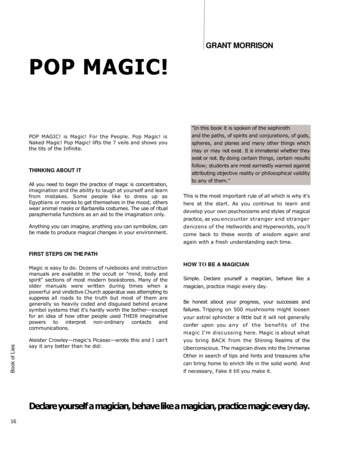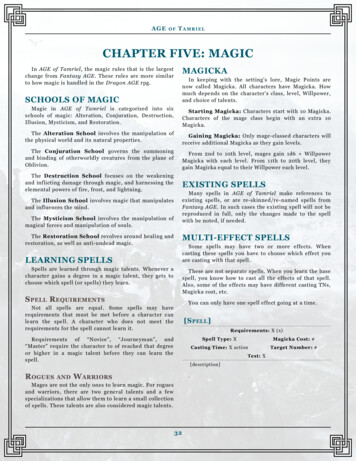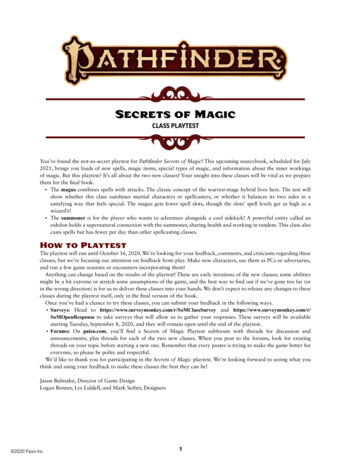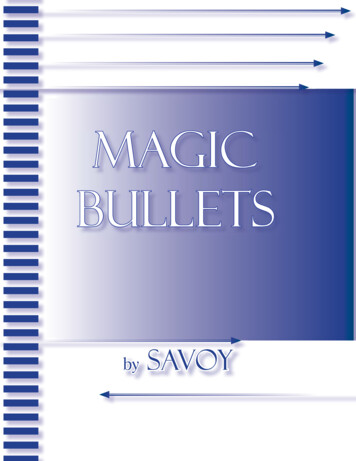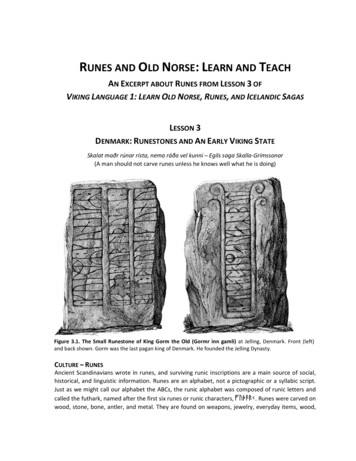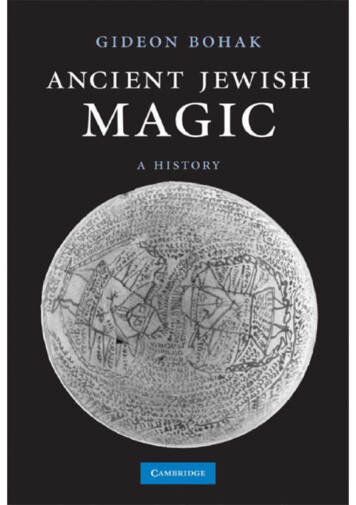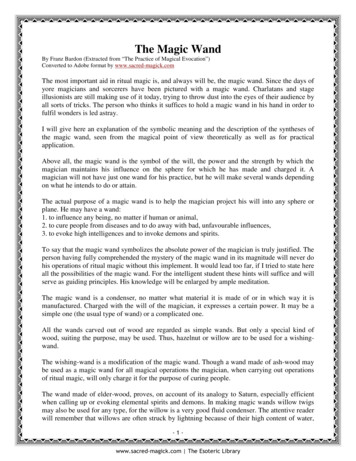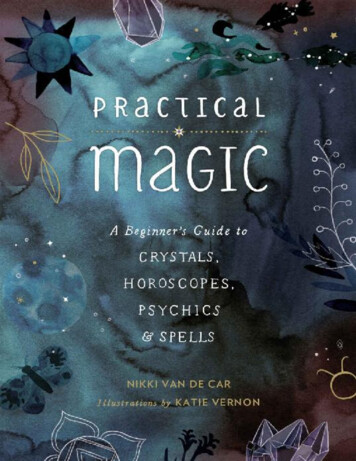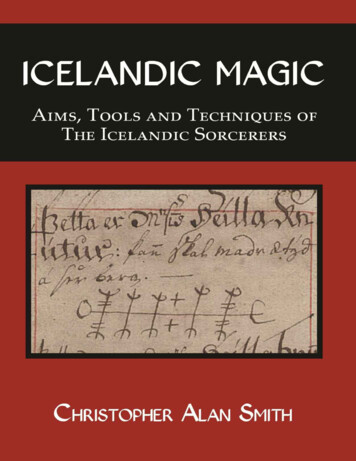
Transcription
Icelandic MagicAims, tools and techniques of the Icelandic sorcerersChristopher Alan SmithP UBLISHED BY AVALONIAwww.avaloniabooks.co.uk
TABLE OF CONTENTSACKNOWLEDGEMENTSINTRODUCTIONA NOTE ON ORTHOGRAPHY AND P RONUNCIATIONCHAPTER 1 - ICELANDIC MAGIC IN CONTEXTTHE ENVIRONMENTAND THE ECONOMYLAW AND LAW ENFORCEMENTVERNACULAR LITERACYRELIGION AND ATTITUDES TO MAGICCONCLUSIONCHAPTER 2 - THE BOOKS OF MAGICAM 434 A 12MO ‘LÆKNINGAKVER’ (CA 1500)ATA, AMB 2, F 16:26 ‘ISLÄNDSKA SVARTKONSTBOKEN (BOOK OF MAGIC)’ (1550-1650?)LBS 143 8VO ‘GALDRAKVER’ (CA 1670)LBS 2413 8VO ‘RÚNA- OG GALDRAKVER’ (CA 1800)LBS 764 8VO (CA 1820)Í B 383 4TO ‘HULD’ (CA 1860)CHAPTER 3 - PURPOSES AND PREOCCUPATIONSTHE QUESTION OF ‘WHITE’ AND ‘BLACK’ MAGICAPOTROPAIC MAGICFARMING, FISHING AND TRADEFRIENDSHIP, FAVOUR AND INFLUENCECRIME AND DISPUTESHEALINGLOVE AND SEDUCTIONDIVINATIONGAMES AND SPORTSLUCK AND WISHESSPELLS OF PURELY MALIGN INTENTCONCLUSIONSCHAPTER 4 - THE MAIN TECHNIQUES OF ICELANDIC MAGICTHE PRIMACY OF THE MAGICAL SIGN AS A VEHICLE OF THE INTENTAPPEALS TO SUPERNATURAL ENTITIESTALISMANSTHE IMPORTANCE OF INCANTATIONTHE METHODS OF DELIVERY
DIRECTCARVINGBRINGING A PREPARED SPELL INTO DIRECTCONTACT WITH THE TARGETINGESTIONDELIVERY BY PROXIMITYDELIVERY FROM A DISTANCEDIVINATIONRITUAL WASHINGCONCLUSIONSCHAPTER 5 - THE TOOLS OF ICELANDIC MAGICTHE CARVING INSTRUMENTFINGERSKNIVES, AWLS AND SCISSORSP ENS, PENCILS AND CHALKMATERIALS USED FOR CARVINGTHE CARVED SURFACESCLEAR CHOICESWOODP APER AND PARCHMENTMETALSBONES, HUMAN AND ANIMALSEA CREATURESUSE OF BODY FLUIDS AND EXCRETIONSHERBS AND VEGETABLE PREPARATIONSCONCLUSIONSCHAPTER 6 - TIME AND SPACECONCLUSIONSCHAPTER 7 - THE PERSISTENCE OF HEATHEN BELIEFCHAPTER 8 - RUNES, CIPHERS AND SECRECYCONCLUSIONSCHAPTER 9 - SOME PROMINENT THEMES AND THEIR APPLICATIONSÆ GISHJÁ LMURKAUPALOKI – THE BARGAIN SEALER‘LOVE’ SPELLSDISPUTES AND LAWSUITSBRÝNSLUSTAFIR – KEEPING SHARP IS GOODCHAPTER 10 - THE ISSUE OF COMPLEXITYCHAPTER 11 - CONCLUSIONSWHO PRACTISED MAGIC, AND WITH WHATTECHNIQUES AND TOOLS – SUMMARYINTENTIONS?
THE CONSTRUCTION OF THE STAVES – CAN ANY SENSE BE MADE OF THIS?FINAL CONCLUSION: HOW ARE WE TO TYPIFY ICELANDIC MAGIC?WORKS CITEDSUGGESTIONS FOR FURTHER READINGENDNOTES
ICELANDIC MAGICCopyright 2015 Christopher Alan SmithPublished by AvaloniaBM AvaloniaLondonWC1N 3XXEngland, UKwww.avaloniabooks.co.ukThis Kindle edition, January 2016Cover image: Luck Knot from Lbs 2413 8vo. Reproduced with kind permission from the National and University Library ofIceland.Interior illustrations and images as credited.Design by Satori, for Avalonia.British Library Cataloguing in Publication Data. A catalogue record for this book is available from the British Library.All rights reserved. No part of this publication may be reproduced or utilised in any form or by any means, electronic ormechanical, including photocopying, microfilm, recording, or by any information storage and retrieval system, or used inanother book, without written permission from the author.
ABOUT THE AUTHORChristopher Alan Smith was born in Nottingham in 1954. He has travelled widely and lived in the Netherlands for five years,where his innate talent for languages enabled him to speak fluent Dutch within a few months and work as a logistics coordinator for amajor transport company. His travels also include three visits to Iceland; on the second visit, he stayed in the country for 8 months andworked as a volunteer at the Museum of Icelandic Sorcery and Witchcraft in Hólmavík.Christopher’s interest in magic began when he was a student at the University of Sheffield, at which time the main emphasis inthe available literature was on the Western Tradition of Kabbalistic magic. However, his taste for travel, languages and a restless searchfor knowledge clearly indicated Woden as his example, leading him within a few years towards Rune Magic and ultimately tomembership of the Rune Gild. His Fellowship Work for the Gild, “The Icelandic Tradition of Magic” was published in 2012 as part of thecollection “Occult Traditions” (Numen Books). In 2014 he was awarded the title of Master in the Rune Gild for his Master-work“Icelandic Magic in the Early Modern Period”, which forms the basis of this book.As he wryly comments in the introduction, “As my sixtieth birthday was approaching, I realised that I should perhaps have startedon this project about forty years ago, beginning by studying Icelandic and folklore at university instead of politics but one has to startsomewhere.”Today he lives in North Yorkshire and, when not practising and researching Icelandic magic, works as a freelance translator.
ACKNOWLEDGEMENTSThanks are due to many people for their help in the completion of this book. Firstly, I thank myparents, who gave me a taste of knowledge and the best education that I was capable of absorbing. Ialso thank my friends and colleagues in the Rune Gild (especially my former Master and mentor,Dave Lee) for their interest and encouragement, and for providing many helpful references. Inparticular, I would like to thank the following individuals, some of whom are Gild members andothers not:Steve Wehmeyer, Michael Moynihan, Michael Putman, Kees Huyser and Mark Patton, forpointing me to many useful resources; my fellow researcher Justin Foster, who has shared much of hisown material with me; Sverrir Guðmundsson, Ingibjörg Benediktdóttir, Benedikt (Bjössi) Peturssonand Signý Olafsdóttir for helping with the translation of the Huld Manuscript; Alaric Hall for hisadvice and for obtaining photographic copies of two manuscripts; Sigurður Atlason, curator of theMuseum of Icelandic Sorcery and Witchcraft, for his help and kindness when I worked as a volunteerat the museum; Magnús Rafnsson for patiently answering many questions with regard to his book‘Tvær Galdraskræður’; Terry Gunnell for his advice on aspects of Icelandic folklore; MatthewDriscoll of the Arnamagnaean Institute for promptly providing me with digital copies of AM 43412mo; my friend Damon Lycourinos for his encouragement and unwavering faith in my abilities as aresearcher; and, last but not least, my partner Laurie for prodding me to stick to the task and forensuring that I had the time to devote to the project.Acknowledgements with regard to the illustrations:All images derived from the manuscripts Lbs 143 8vo, Lbs 2413 8vo, Lbs 764 8vo and ÍB 3834to (the ‘Huld MS’) are reproduced with kind permission of the National & University Library ofIceland. All images from AM 434 12mo ‘Lækningakver’ are reproduced with kind permission fromthe Arnamagnæan Institute in Copenhagen and its photographer Suzanne Reitz. The images from ATA,Ämbetsarkiv 2, F16:26 ‘Isländska Svartkonstboken’ (Photographer: Bengt A. Lundberg), generallyreferred to in the text of this book as ‘the Stockholm MS’, are reproduced with kind permission fromthe Swedish National Heritage Board.
INTRODUCTIONMore than any other country, perhaps, Iceland has an iconic status for students of ancientGermanic lore and culture. The reasons for this are not hard to seek. The environment itself isdramatic, the perfect setting for tales of heroism and magic. A sub-Arctic island, oft-times battered bythe cold waves of the North Atlantic Ocean and storms from the polar region, it is a land of glaciersand volcanoes where the primal forces of fire and ice compete to increase the hardship of the smallpopulation. Summers are brief and winters long, while spring and autumn struggle to find any place atall among the seasons. Arable land is hard to find, and even good grazing is at a premium. The earthitself shakes and rumbles from time to time. It is a land of liminality, where the world of men issqueezed and constricted between vast and hostile forces.Remarkably, however, Iceland is less famous for its geography than for the vast outpouring ofliterature that its people have produced, especially in the Middle Ages. The very word ‘saga’,meaning ‘story’, has passed into English to denote a tale that is epic and heroic. From the earliestsettlement at the end of the ninth century, Icelanders developed, passed on, and eventually recordedthe tales of their lives, first by oral tradition and eventually through the establishment of a strongtradition of vernacular literacy. The written word was highly prized, and even today Iceland has thehighest percentage of published authors per head of population in the world. It is mainly thanks to thisvast output of literature, much of it written about two centuries after the country accepted Christianity,that we can form an idea about the pre-Christian beliefs, social customs and religious practices of ourGermanic ancestors.Another factor is that the people of Iceland jealously guard and preserve their culture. Thoughpredominantly Lutheran by religion these days, they are as familiar with the mythic tales of Thor andOdin as they are with tales from the Bible. Even young children are taught at school to recite “Þatmælti mín móðir”, the first poem of the famous Viking, poet and sorcerer Egill Skallagrímson. TheIcelandic language has changed little over the past thousand years, certainly in comparison to itslinguistic relatives in Scandinavia, the European mainland and the English-speaking world, and thecountry’s educational establishment does its best to prevent the adoption of foreign words.Furthermore, belief in the old Germanic pantheon is making a modest comeback and, although theratio is still small, Ásatrú – belief in the Æsir – is an officially recognised religion with a growingnumber of adherents. One can therefore certainly speak of a ‘living tradition’ that is more than ofmerely antiquarian interest.From the elaborate sagas of the Middle Ages to the folk tales and legends collected andrecorded by Jón Árnason in the nineteenth century, the stories of Iceland are shot through with magicand dealings with supernatural beings such as elves, land-wights, ghosts and trolls. Even today, manyIcelanders attach credence to the continued presence of the ‘hidden folk’; even if they do notabsolutely believe in elves, they would not go so far as to categorically deny their existence. It haseven been known for a major road to be diverted so as to avoid disturbing a place where the hiddenfolk are reputed to have their home. Of particular interest, in terms of magical practice, is the Strandirdistrict of the Westfjords Region. Although this formerly remote and inaccessible area does not
feature greatly in the sagas, its inhabitants came to acquire a reputation for prowess in the magicalarts by the seventeenth century, and in 1930 a variant of the magic sign ‘Ægishjálmur’ (Helm of Awe,or Helm of Aegir) was adopted as the official emblem of Strandir. To capitalize on this aspect oflocal history and boost tourism, the Museum of Icelandic Sorcery and Witchcraft (Galdrasýning áStröndum) was founded in 2000 at Hólmavík, the district’s main population centre. The museumfocuses on the 17th Century, when the European fashion for persecuting witches and sorcerers foundits way to Iceland, with the result that a number of individuals were tried, convicted and punishedwith various degrees of severity. The museum houses an eclectic and fascinating collection ofexhibits illustrating magical practices at that time: the ‘Tilberi’, a kind of vampiric worm; the ‘seamouse’ (captured in order to gain money); a fish’s head raised on a pole in order to control the winds;and, of course, the world-famous Nábrók or ‘necropants’. It also has a display of reproductions of thegrimoires that have survived the age of persecution and are now preserved in the National Libraryand the Arni Magnusson Institute in Reykjavik.These grimoires (galdrabækur, or ‘books of magic’) in the Icelandic National Library and theArni Magnusson Institute, together with other old manuscripts relating to runes and magic, are, orcertainly should be, of great interest to anyone with a serious interest in the authentic practicalities ofGermanic magic. They are certainly not hidden from view, as many of them have been catalogued onthe website www.handrit.is together with others in the Arnamagnaean Institute in Copenhagen, andeven made available as digitized copies, which one can download. So far, I have been able toidentify 21 such manuscripts, and there are almost certainly more of them waiting to be listed. Theearliest, AM 434 a 12mo ‘Lækningakver’ dates from between 1475 and 1525; the most recent, ‘Rún’,dates from 1928. In addition, there is the intriguing publication ‘Galdraskræða’ from 1940, in whichJochum Eggertsson, writing under the pen-name ‘Skuggi’, collated and presented the materialcontained in some of the manuscripts. This has recently been republished in hardback and in asomewhat different format.Given the availability of this material, it comes as something of a surprise that nobody has yetattempted a comprehensive survey of Icelandic magic in the early modern period. Much has beenwritten about magic and witchcraft in the Middle Ages, but most of these works tend to focus on theanthropological, ethnographic or sociological perspectives without much consideration for thepracticalities, the ‘nuts and bolts’ if you like, of magic in northern Europe. François-Xavier Dillmann,in his monumental work “Les Magiciens dans l’Islande Ancienne” (2006), has made an extensivestudy of Icelandic magicians based on the saga literature, but he devotes only one chapter to how theyactually proceeded in their work. Dr Stephen E. Flowers has translated and published one Icelandicgrimoire contained in the Swedish national archives, together with commentary and some appendicesbased on an earlier, secondary work, under the title “The Galdrabók” (1989). Matthías Sæmundsson(1954-2004) published two books, “Galdrar á Íslandi. Islensk galdrabók” (1992) and “Galdur ábrennuöld” (1996) but, unfortunately, these are not available in English. In 1903, Ólafur Daviðssonpublished “Islaendische Zauberzeichen und Zauberbuecher” in German, but he based his analysis on afew, mainly late, manuscripts and did not go into any great detail regarding the operations of theIcelandic magicians.An even greater surprise is that these preserved volumes of Icelandic sorcery have been so littleexploited and largely ignored by modern practitioners of Rune magic. Instead, much emphasis is
given to the characters of the various Futhark rows (Elder, Anglo-Frisian and Younger) and theiresoteric interpretation, mainly based on the evidence of three Rune poems and a handful ofarchaeological finds whose magical significance will always remain the subject of debate. As will beseen, the use of Runic characters continued in Iceland, with explicitly magical associations, forhundreds of years after the conversion; not only that, there were many possible Rune-rows, many ofwhich are virtually unrecognisable to those educated only in the Elder Futhark and its derivatives. Onthe other hand, the use of Runes plays a relatively minor part in the early modern magic of Iceland. Isit possible that we have been barking up the wrong tree all the time?This also raises the thorny issue of semantics and terminology. What is magic? What is agrimoire? Is a book of magic necessarily a grimoire? Most importantly, is an Icelandic book of magicby definition a book of Icelandic magic? One can agonise interminably over such definitions; indeed,some academics do so, excruciatingly so, with the net effect that the reader has to plough through theirworks with gritted teeth and perhaps even lays the book down in despair before coming to the mainconclusions. As Richard Kieckhefer has pointed out, magic in the Middle Ages – and this appliesalso to the early modern period – is a kind of crossroads where different pathways in cultureconverge. A leechbook, or book of healing, might contain items that would be considered perfectlysensible to the average person today, such as the preparation of a soup with certain herbs to cure astomach ache; but the same recipe might well be accompanied, as an integral part of the exercise, bythe command to collect the herbs at a certain time of day or phase of the moon, and to say a prayer,charm or incantation as they are being prepared. Likewise, a curse on an enemy might contain appealsto the Christian god or commands in his name: does that make it a matter of religion rather than ofmagic? For the present purpose, I will therefore consider a ‘magical’ operation as anything thatinvolves the use of signs, staves, incantations, charms or appeals to some unseen power to achieve aneffect that could not ordinarily be achieved by physical, chemical or biological action. As regards thedefinition of ‘book of magic’, I include any volume in which a significant part is devoted to suchmagical operations, and I use the term ‘grimoire’ very loosely to describe a book of magic.The most recent grimoire referred to in this work dates from around 1860. When referring toIceland, terms such as ‘mediaeval’, ‘renaissance’ and ‘early modern’ can be deceptive because of thedistinctly different level of development, as will be seen in Chapter 1. For example, in his “Historyof Iceland” Jón R. Hjálmarsson writes: “To give an indication of the importance of telegraphy, it hasbeen said that only with its introduction [in 1906] did the Middle Ages finally come to an end inIceland.[1]”My ultimate aim, as first conceived, was extremely ambitious: to fill this gap in knowledge byproducing a comprehensive survey of the techniques of Icelandic magic, based on a reading of all theextant grimoires and a thorough reading – in Icelandic – of the relevant chapters in both volumes ofJón Árnason’s “Íslenzkar Þjóðsögur og Æfintýri”. As my sixtieth birthday was approaching, however,I realised that I should perhaps have started on this project about forty years ago, beginning bystudying Icelandic and folklore at university instead of politics. Therefore, I shall concentrate insteadon what I can actually do at the present time. Given the current level of my ability in the Icelandiclanguage, I will focus on five grimoires that have already been translated into English (referringwhere necessary to the original manuscript), one grimoire that I have succeeded in translating fromthe Icelandic, and such folk tales and legends as have already been translated into English. Given
time, diligence and patience, I may yet succeed in producing a definitive work on Icelandic magic, butone has to start somewhere. A study of Icelandic magic based on thorough analysis of six originalmanuscripts is still a considerable achievement and has – as far as I know – never been attemptedbefore. All the illustrations of the magical signs and images have been faithfully reproduced from theoriginals and are not copied in my own hand. This has the advantage of avoiding transcription errors,a problem which plagued even the owners of the original books of magic.Finally, a word of warning: this is not a book of instruction on ‘how to perform Icelandicmagic’, and some may find it rather dry reading. However, if you are looking for a book that presentsthe facts, you have come to the right place.
A Note on Orthography and PronunciationThe Icelandic alphabet contains a number of characters that are not used in English.Furthermore, the pronunciation of vowels can be considerably changed by the addition of an accentover them. Here follows a brief guide to these characters and their pronunciation.ÞPronounced with a hard ‘th’, as in ‘thorn’.Ð/ðPronounced with a soft ‘th’, as in ‘this’.J/jPronounced as ‘y’ in English.G/gPronunciation varies; usually hard (as in ‘get’) at the beginning of words, a ‘y’ sound in the middle (ægishjálmur),and ‘ch’ (as in ‘loch’) at the end.Æ/æPronounced as the English word ‘eye’.öPronounced like the ‘u’ in the English word ‘blur’.aAs in British English ‘man’.áAs in the exclamation ‘ow!’eAs in British English ‘men’.éAn ‘e’ preceded by a ‘y’ sound, as in ‘yes’.i/yA short ‘i’, as in ‘lift’.í/ýA long ‘i’, as in ‘bean’.oA short ‘o’, as in ‘cod’.óA long, more rounded ‘o’, as in ‘goat’.uA short ‘u’, as in ‘but’.úA long ‘u’, as in ‘moot’.eiRoughly as in English ‘their’.auDoes not exist in English; best reproduced by pronouncing an open ‘a’ (as in the exclamation ‘ah’), immediatelymerging into a closed ‘u’ as in French ‘tu’. Somewhat similar to Dutch ‘ui’ but quite different to German ‘au’.
CHAPTER 1ICELANDIC MAGIC IN CONTEXTThe present work is by no means intended as an ethnographic study, nor is it my purpose todevote any great attention to the witchcraft trials of the 16th to early 18th centuries. However,something must at least be said about the people who practised magic and took the trouble to commitsome of their operations to writing, and about the world they inhabited. Only then can we fullyunderstand the purposes and preoccupations that emerge from the grimoires.
The environment and the economyFirst of all, one must consider the geographic and economic environment of Iceland in the earlymodern period. Life here on the very fringe of the European sphere was undoubtedly very harsh. Intotal area, the island is nearly four-fifths the size of England, but of this area only 23% is vegetatedand able to support farming of any kind. As already mentioned in the introduction, arable land isscarce and most farming is pastoral, predominantly involving sheep. Indeed, the Icelandic word fécan mean either ‘sheep’ or ‘money’, depending on the context, which shows how important livestockfarming was. The interior of the country is dominated by glaciers and vast, uninhabitable wastes ofvolcanic grit, so most of the human populace tends to hug the coastline or inhabit the grassy valleysextending inland. The bounty of the sea, in the form of fish, whales, seals and seabirds, has alwaysbeen essential to economic prosperity (if one could call it prosperity in the early modern period).Driftwood from the sea was often the only source of timber for some isolated communities in thistreeless environment[2]. The population, therefore, tended to live in very scattered communities –mostly isolated farmsteads – and Iceland had hardly even any villages until the 18th Century (evenReykjavík did not become a town until 1786). Roads and bridges were almost non-existent, and mosttravel and transport on land was done either on foot or by utilizing the sturdy Icelandic ponies, theloads being strapped onto their backs rather than hauled by cart. Astonishingly, even thewheelbarrow, a simple but highly useful tool, did not arrive in Iceland until the nineteenth century.Throughout much of the period under consideration, the people of Iceland also had to contendwith other factors that only served to increase hardship. There was the period of climatic coolingfrom approximately 1550 to 1850, bringing harsher winters and shorter summers. Several majorvolcanic eruptions occurred, culminating in the disastrous Laki eruption of 1783-1785, reducing thehuman population by a quarter and bringing it to such a parlous state that the Danish government(which ruled Iceland at the time) even considered evacuating the country entirely. Nor did Iceland’srelative geographic isolation give it any protection against the plagues that ravaged Europe until themid-seventeenth century, or from the attentions of Barbary pirates. On top of all this, all trade withthis, Denmark’s province, was given into the hands of a select number of Danish merchants from 1602until 1787, and the Icelanders were effectively fleeced under this monopoly. To quote Jón R.Hjálmarsson, “It has been said that of the many plagues which have afflicted the Icelanders in thecourse of the centuries, the Danish trade monopoly was probably the worst”[3].Figure 1: Turf house of the type common in Iceland until the 20th Century
Law and law enforcementSecondly, we must give attention to the system of law and its enforcement, for this also has abearing on the purposes of the various operations detailed in the grimoires. In this respect, it is worthquoting Magnús Rafnsson at length. Although he refers specifically to the witchcraft trials of the 17thCentury, his description has a bearing on the process of law in general:“Iceland was a rural society with no towns or villages and the local authority was thedistrict commissioner or sheriff, who was also the local judge. These districts werearound twenty in the country, each one divided into several communities or parishes.Two men were chosen to be head sheriffs or lawmen, each over one half of the country.The sheriff attended hearings each spring in the parishes where charges or suspicionsof illegal activities were put to him. The sheriff could also call an assembly at othertimes if serious cases were brought to his attention. He acted as prosecutor and namedhis co-judges to decide guilt or innocence with him. If the result was a sentence ofguilt, the sheriff decided the punishment. Some cases never went beyond the parishcourts. The two lawmen acted as an intermediary court and could call on the lawcouncil of the parliament at Þingvellir, which by this time had lost its legislativepowers. But the law council settled disputes over the law and it ratified deathsentences, in some witchcraft cases after executions had taken place according to adecision by the lawmen. After 1663 all cases where guilt meant a death sentence had tobe put to the law council of the general assembly.”[4]There was no constituted police force at this time or any other means for the proper detectionand recording of crime. In most cases, therefore, unless sufficient evidence was present to make itworthwhile bringing a case to the attention of the sheriff, it was very much up to each individual toresolve his own problems with errant neighbours. As society was stratified, ranging from daylabourers, tenant farmers and yeomen farmers of modest means to owners of considerable estates andthe Crown bailiffs, justice and the chance of a fair hearing were far from assured.
Vernacular literacyThe people of Iceland may have been poor, but for the most part they were certainly not lumpenor dull of wit. Before the adoption of Christianity, a strong tradition of orally communicated learninghad existed; skaldic story-tellers from Iceland at one time held a virtual monopoly at the Norwegianroyal court, and Lawmakers on the island were expected to memorise all the Commonwealth’s lawsby rote long before they were ever committed to parchment. Nor were they wholly unfamiliar withwriting, for the runic characters were used to carve messages of a mundane nature as well as inmagic, and this tradition did not die out completely. With the coming of Christianity, however, therecame a new emphasis on the written word, the use of the Roman alphabet, and writing on parchmentrather than carving on wood, bone or stone. This made it easier to commit much lengthier passages towriting, initially in Latin in the scriptoria of monasteries, but to an increasing extent in the vernacularlanguage. At first, only the wealthier chieftains could afford to send their sons for an ecclesiasticaleducation, but there must have been a ‘trickle-down’ effect into society at large for, as GisliSigurðsson writes:“Manuscripts were read out loud in the Middle Ages, and as book ownership becamemore common in later centuries this custom continued, even after printing had begun. Inhis description of Iceland from 1590, Oddur Einarsson says that farmers in Icelandentertained and delighted their guests by reading for them for hours from the sagas. Inthe eighteenth century it was still the main form of leisure in the evenings to read theold Icelandic sagas and recite ballads, a custom which continued into the twentiethcentury. It was more common for women than men to tell stories – adventures, ghoststories, stories of hidden people, or ‘stories of all things, dead and alive, betweenheaven and earth’, as Ingibjörg Lárusdóttir (1869-1949) described the subjects told byan old woman from the Húnavatn district in the northwest. People also retold printedstories, Icelandic and foreign, and itinerant travellers could find work at farms asstorytellers.[5]”
Religion and attitudes to magicBy general consensus (though, it must be said, under considerable pressure from the King ofNorway, Olaf Tryggvason), Iceland had adopted Christianity at the Althing of the year 1000. Over theensuing centuries, various proscriptive acts of the Roman Catholic Church had sought to extirpate alltraces of the old religion. At first, adherents of the old gods were allowed to worship them in private,but already by 1121 the ascetic Bishop Jón Ögmundsson of Hólar had decreed that even the names ofthe week days were to be changed: Týr’s day became ‘third day’, Odin’s day became ‘mid-weekday’, Thor’s day became ‘fifth day’ and Freya’s day became ‘fast day’. Loður’s day[6] (Saturday)became ‘bath day’, while the sun and moon were considered sufficiently part of the Christian god’screation to retain their respective days. As will be shown, the attempt to eliminate every facet ofbelief in the gods of the old religion was not entirely successful, for appeals to them still crop up inthe grimoires of the seventeenth century and beyond, but it is very doubtful whether any organised cultof Odin still existed by this time[7]. The Roman Catholic period lasted until 1550, when the Lutheranfaith was imposed by the Danish king and native Icelandic converts after a series of bloodyconfrontations culminating in the execution of the last Catholic bishop, Jón Árason.Even in the Icelandic law book of 1281, “sorcery, soothsaying, waking up trolls, and heathenpractices” [8] were included with murder in the list of capital offences, but sorcery and witchcraft donot appear to have been persecuted with any great vigour in the Catholic period. There was only oneburning, of a sister in a convent, and this was for blasphemy rather than witchcraft. Accor
table of contents acknowledgements introduction a note on orthography and pronunciation chapter 1 - icelandic magic in context the environment and the economy law and law enforcement vernacular literacy religion and attitudes to magic conclusion chapter 2 - the books of magic am 434 a 12mo 'lÆkningakver' (ca 1500) ata, amb 2, f 16:26 'islÄndska svartkonstboken (book of magic)' (1550 .
